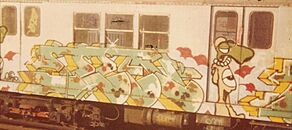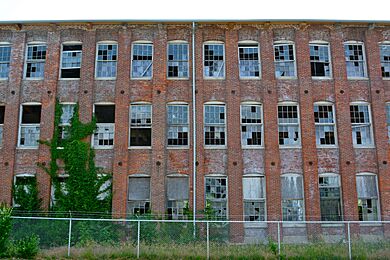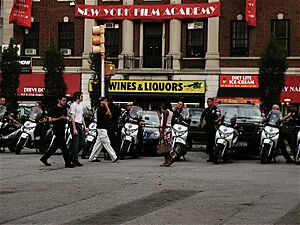Broken windows theory facts for kids
The Broken Windows Theory is an idea in criminology, which is the study of crime. It suggests that visible signs of small acts of disorder, like a broken window or graffiti, can create an environment that encourages more rule-breaking and even more serious problems. The theory proposes that if small issues are addressed quickly, it helps create a feeling of order and respect for rules. This can prevent bigger problems from happening.
This idea was first shared in 1982 by social scientists James Q. Wilson and George L. Kelling. It became well-known in the 1990s, especially when William Bratton, the police commissioner in New York City, used it to guide police actions.
The theory has been discussed a lot by experts and the public. Some police actions based on this theory have been debated, like the frequent stopping of people for questions in New York City in the years leading up to 2013.
Contents
Understanding the Broken Windows Theory
The theory explains how the condition of a place can affect rule-breaking. It focuses on three main ideas: social norms (unwritten rules), whether people are being watched, and what signals the environment sends.
In a busy city, it's not always clear what the social rules are or if someone is watching. So, people often look at their surroundings for clues. The general appearance of an area can be a big clue.
How Our Surroundings Send Messages
According to the Broken Windows Theory, a clean and well-kept place sends a message that the area is cared for and that bad behavior won't be allowed. On the other hand, a messy place with broken windows, graffiti, or lots of trash sends a different message. It suggests that no one is watching, and people can get away with rule-breaking.
The theory believes that places "talk" to people. A broken window that isn't fixed tells people who might cause trouble that the community isn't paying attention. It suggests the community might not be able or willing to protect itself. It's not just the broken window itself that matters, but the message it sends. It symbolizes that the community might be vulnerable. Neighborhoods where people work together often fix broken windows quickly. This shows they care about their space.
The theory looks at both the physical environment and how people behave within it.
How Small Problems Can Grow Bigger
If a broken window is left unfixed, residents might start to feel differently about their community. To stay safe, people might spend less time in shared public spaces. This can cause a strong community to weaken. The slow decline of a community, starting with small problems, changes how people use their shared spaces. This can break down the community's ability to keep order.
When people causing trouble start to appear, it can signal that the community isn't able to keep things in order. Citizens might become afraid that worse things will happen. As a result, they might spend less time outside and feel less connected to their community if these problems continue.
Sometimes, people who live in a community might tolerate small problems because they feel they belong there. But issues arise when "outsiders" start to disrupt the community's way of life. The actions of "regulars" show the community's culture, while "strangers" might not fit in.
This can make everyday activities feel uncomfortable for residents, as the community's atmosphere changes from what it once was.
The Broken Windows Theory helps explain how people interact with their environment. A community's culture can change over time, especially with the influence of unwanted people and behaviors. This theory shows how people shape their spaces through their actions and how spaces can also shape people's daily decisions.
When police work to remove unwanted disorderly people, it suggests that people's actions shape their space. Public rules help decide how people should behave. Every place has its own rules of conduct, and what is considered right can differ from one place to another.
The idea also considers how certain behaviors can lead to people being excluded from spaces. If someone's behavior doesn't fit the community's standards, they might be seen as unwanted. A community with strong social control sends a clear message to those who might cause trouble: their behavior is not tolerated. If a community can't manage this on its own, police efforts can help.
By removing unwanted people from public areas, residents can feel safer and have more respect for those who protect them.
Key Ideas Behind the Theory
Community Helps Keep Order
Many believe that informal social control can help reduce unruly behavior. This means that everyday relationships and community groups are often more effective than just laws. When citizens take action and show that disorderly conduct is not tolerated, it creates a "tough" attitude against problems.
Jane Jacobs was an early thinker on this idea. Her book, The Death and Life of Great American Cities, talks about how residents and local businesses help keep order on the street. She called this having "eyes on the street," meaning people are watching out for their neighborhood.
However, sometimes people don't want to get involved, feeling it's not their job to fix problems. Others might be afraid to step in. Even though community involvement is important, Wilson and Kelling believed that the police are key to keeping order.
The Role of Feeling Safe
Feeling safe is a very important part of the Broken Windows Theory. Public disorder can make people feel afraid. As people see more disorder, their fear can grow, which can weaken the community and make residents feel disconnected. Wilson and Kelling suggested that fear comes from small acts of disorder, not just serious crimes. When people are afraid, they might avoid each other, which further weakens community connections.
Broken Windows vs. Zero Tolerance
The Broken Windows Theory is sometimes confused with "zero tolerance" policing. Zero tolerance means very strict punishment for even minor offenses. However, Wilson and Kelling, and others like William Bratton, have said that Broken Windows policing is different. They believe that people who commit minor offenses should receive fair, and sometimes lenient, punishment, focusing more on fixing the problem than just punishing.
Real-World Examples and Studies
The Car Experiment (Philip Zimbardo)
In 1969, a psychologist named Philip Zimbardo did an experiment to test this theory. He left a car with no license plates and its hood up in a neighborhood in the Bronx, New York. He also left a similar car in Palo Alto, California. The car in the Bronx was attacked within minutes. A family was the first to take parts from it. Within a day, everything valuable was gone. After that, the windows were smashed, and children used it as a playground.
The car in Palo Alto stayed untouched for over a week. Zimbardo then smashed one of its windows himself. Soon after, other people joined in the destruction. Zimbardo noticed that many of the adults who caused damage in both cases seemed like respectable people. This experiment suggested that in an area where neglect and theft are common, vandalism happens faster because the community seems to care less. It shows that when signs of neglect appear, the sense of community care can break down anywhere.
Changes in New York City

In 1985, George L. Kelling, one of the theory's authors, became a consultant for the New York City Transit Authority. Later, he also advised police departments in Boston and Los Angeles.
David L. Gunn, who was President of the New York City Transit Authority, used Kelling's ideas. From 1984 to 1990, he led a big effort to remove graffiti from the New York subway system.
In 1990, William J. Bratton became the head of the New York City Transit Police. He was inspired by Kelling's work. He made rules stricter for things like not paying subway fares and made it faster to process people who were arrested.
When Rudy Giuliani became Mayor of New York City in 1993, he hired Bratton as his police commissioner. They applied similar ideas across the whole city. Their policies focused on addressing small problems that affected the quality of life. For example, police officers were told to be stricter about minor offenses like not paying subway fares, drinking in public, and graffiti.
Studies in the early 2000s suggested that both small and serious crimes in New York City dropped significantly after these policies were put in place. Crime continued to fall for the next ten years. This data suggested that policies based on the Broken Windows Theory were helpful. However, other studies have debated whether these policies were the direct cause of the crime drop. They pointed out that crime rates were also falling in other cities with different police policies and that other factors, like a drop in unemployment, might have played a role.
Lessons from the Netherlands
In 2007 and 2008, researchers from the University of Groningen in the Netherlands did experiments to see if visible disorder, like trash or graffiti, led to other types of rule-breaking, such as theft or more littering. They set up different urban locations. In some, they created a "disorder" condition with visible graffiti or litter. In others, there was no disorder. They then secretly watched to see how people behaved.
Their observations supported the theory. They concluded that "One example of disorder, like graffiti or littering, can indeed encourage another, like stealing."
How This Theory Affects Us
Impact on Schools and Learning
The Broken Windows Theory is also used in education to help keep order in classrooms and schools. The idea is that students see disorder or rule-breaking and might start to imitate it. Some school programs encourage clear rules to help students behave well. These rules might cover how students speak, classroom manners (like sitting straight), what they wear (like uniforms), and how they move around the school (like walking in lines).
From 2004 to 2006, researchers from Johns Hopkins University studied how the physical appearance of schools and classrooms affected student behavior. They found that the condition of the school building and classrooms was connected to how students felt about safety and order. Their conclusion was that while fixing broken windows and keeping a school looking good can't solve all problems, ignoring them can lead to a "troubling downward spiral."
Community Appearance and Property Value
Keeping streets clean and well-monitored can have other positive effects. Broken windows and disorder can make an area seem less valuable. Real estate experts might find the theory useful because if small problems are managed, bigger problems might also decrease. This can make homes and apartments more appealing, potentially increasing their value. Fixing up a neighborhood can lead to gentrification, which means an area becomes nicer and attracts new residents and businesses. By reducing disorder, cities can become more attractive to people and investors, improving the city's economy and creating a safer, more pleasant environment.
What the Numbers Say
A large study in 2015 looked at many different ways the Broken Windows Theory was put into practice. It found that strategies focusing on specific "hot spots" (areas with more crime) or solving particular problems often led to a decrease in various types of crime. However, the study also noted that very aggressive strategies that only focused on arresting people for minor behaviors, like public drinking, didn't always lead to significant crime reductions. The authors suggested that police should work more closely with communities to solve problems together.
See also
 In Spanish: Territorio del Norte para niños
In Spanish: Territorio del Norte para niños
- Anti-social behaviour order
- Crime prevention
- Pygmalion effect



